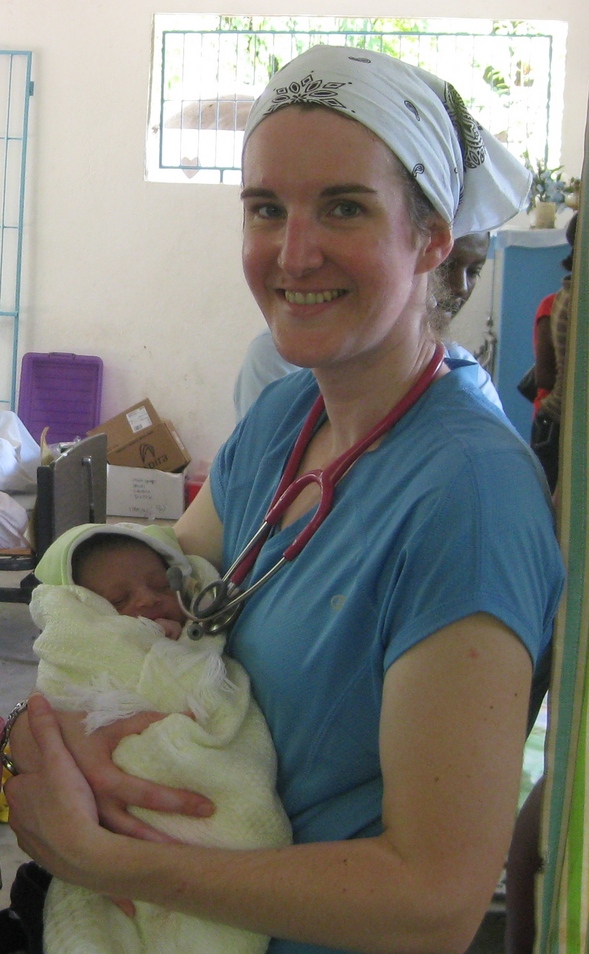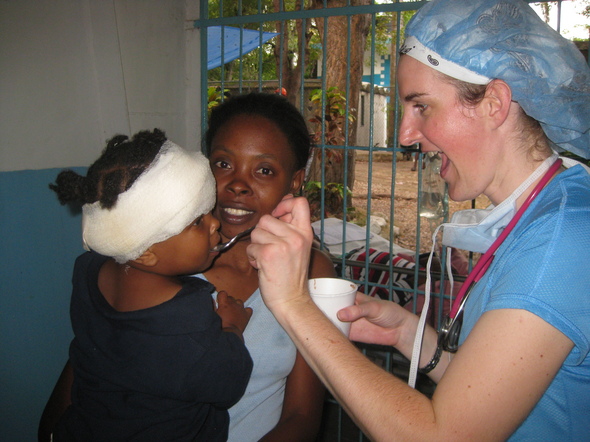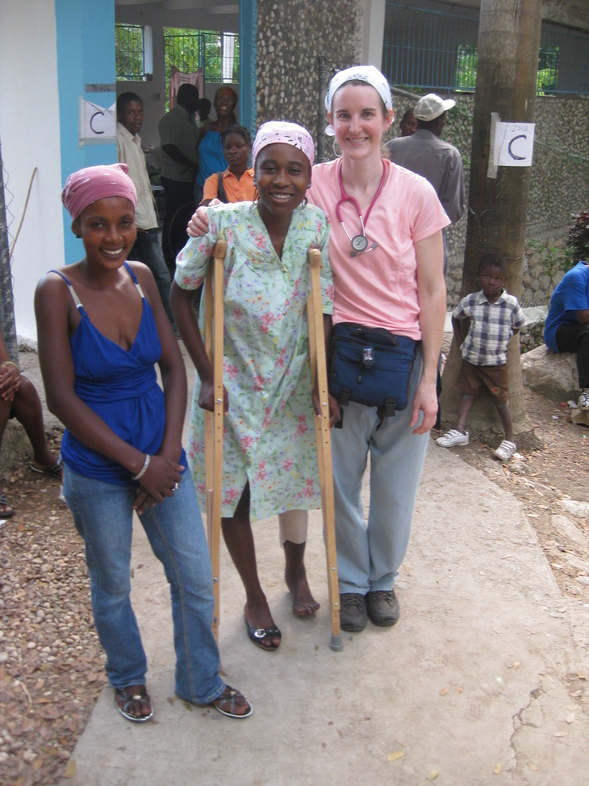Healing the Haitians: A journey of faith and fortitude

Photo courtesy of Bridget Holtz.
However, a short six days prior to their arrival, it was completely unbeknownst to Holtz that she was going to Haiti at all.
“I knew immediately I wanted to be in Haiti,” she said when report of the calamity hit the news, “but I didn’t think I would get there. It was totally God [who got me there].”
It was on the Monday prior to her departure when Holtz received a forwarded email from a group of physicians based out of Philadelphia. They were traveling down to Haiti that Friday and searching for willing nurses to join their efforts.
This group, “Team Ange,” responded to Holtz’s response inquiry within two minutes, she said, saying they wanted her to pack up a lengthy list of supplies and head out to Atlanta in just a few days.
“I’m glad everything happened so fast,” she said, “I didn’t have time to panic at all.”
What was accomplished for her preparation in such little time, she said, was a miracle in itself.
“It was a miracle I was able to go,” she said. “I called my boss asking if I could leave for two weeks [that coming Friday], and she said ‘Well, OK! Let’s make it so you can go.’ ”
Within the week, Holtz’s unit at the hospital raised $1,500 for her trip, including medical supplies.
Team “Ange,” the Creole term for “angel” was also involved in relief efforts after the tsunami in Sri Lanka in 2004, and coordinated rotating groups of nurses, doctors and volunteers to work with trauma victims for a matter of months after the calamity. Holtz was a part of the maiden rotation of Team Ange’s efforts in Haiti.
She boarded a plane from Detroit to Atlanta where she met the rest of her team, and then from Atlanta landing in Santo Domingo. With no commercial airlines allowed in to Port-au-Prince and the weight of their luggage too hefty for smaller local planes, they were left to wait for a seven-hour bus ride the border town of Pedernales, then another 10-hour wait for a Dominican Republic Navy ship to take them to Port Jacmel, Haiti.
Finally Holtz and her fellow medical trauma teammates arrived to the distressed country to help heal the wounded, infected and homeless, amid the broken buildings and rubble-thick air.

Photo courtesy of Bridget Holtz.
Upon their arrival, locals lined the dock, wanting to assist in offloading Team Ange’s supplies for payment in food.
“The port actually looked pretty calm,” Holtz said, “but once you got into the city and away from the ocean was when you got to see the damage.”
Perched atop their luggage in trucks, Team Ange made the final leg of transit into the city, to Center Medical Emmanuel, an outdoor ambulatory clinic erected 40 years ago by a missionary, and their worksite for the next two weeks.
Their work began after nightfall as soon as they climbed off the trucks, she said.
Armed with headlamps, Holtz and her partners began meeting with the trauma victims, swamped with those in desperate need of medical attention. One of their inaugural tasks was to perform an amputation on a young girl with a badly crushed leg.
Much of their initial work was to undo ineffective wrappings and casts that were set by prior relief forces, local doctors or the victims themselves, and having to treat the festering wounds or reset the broken bones. The material that Holtz and her teammates dismantled from the injuries of the victims included banana leaves and small planks of wood from the victims’ own broken houses.
Team Ange quickly established a solid reputation among the victims, Holtz said, although there were challenges to providing quality care in a rustic environment.
“We had no monitors and no fancy equipment, and we were looking at X-rays that weren't the greatest quality … [however] we were not practicing obscene medicine. We were able to treat people with the full spectrum of medication … because of that we were inundated with people,” she said.
Their reputation also led the Red Cross camp located approximately 15 minutes away to send patients to their care.
Holtz’s role within the relief efforts was a combination of administration, nursing support, and that of a physician, which began at 6 a.m. to nearly midnight, she said. With an average of six to ten surgeries a day with 200 to 300 patients daily overall, Holtz assisted in greeting new patients, evaluating injuries and attending to the needs of the rotating 30 person inpatient population. The needs of the victims included a full spectrum of physical care, from orthopedic rehabilitation, treatment for respiratory issues and gangrene.
“I was a pharmacist, social worker, nurse, I delivered a baby, I declared people dead, and I prayed with them while they died,” she said of her changing roles within Center Medical Emmanuel.
Holtz found caring for the earthquake victims a profound experience that mixed the medicinal with the spiritual elements of humanity.
“[Our work involved] literally everything you could think of that the human heart could hold,” she said. “I used part of every part of nursing and every part of humanity doing this. [We were tending to] pure human need, trauma and people who were terrified and vulnerable, people who didn't know where their next breath would come from, and we were there to comfort them.”
However emotionally draining attending to the dying may have been, Holtz said there was benefit in being present to those who had no hope of survival.
“When you reach the point where I couldn’t medically do anything more for [the dying patients], I could just be with them. That was very freeing for me,” she said. “I could just cry with them, pray with them, and demonstrate God for them even if they felt like they couldn’t see him anywhere.”
Holtz’s experience with death in Haiti was also a lesson in Haitian spirituality, which she described as a combination of Christianity and Voodoo. She observed the families’ prayers for their dying as a distinct approach that conveyed their differences with the Christian religion.
This was exemplified during the first death she encountered in Haiti, involving a fatally injured man who had been hit by a bus, where upon his arrival at the hospital was immediately inundated with fervent Haitian prayer.
“Their approach to death was very loud, almost like trying to bring this person back. [The Haitians surrounding the dying man] used commanding prayers, almost like Lazarus was called forth. It was strange,” she said. “I was disturbed by their yelling; it sounded like they were calling forth this escape from death. It was a strange juxtaposition [to our quiet prayers].”
Holtz, despite her initial discomfort with their foreign rituals, was fascinated by their reaction to the event of dying.
“Afterward, [the patient had been deceased] for about five to ten minutes, the nurses and I were emotionally exhausted. But it was fascinating to see the Haitian approach to death. Death is so familiar to them, and that this is how they deal with it. It was not warfare [between our two spiritualities], but a cultural experience.”
The religious differences between the Haitians and Holtz and her teammates were not an issue, she said. Holtz, a Roman Catholic, stated she was extremely peaceful amid the stressful medical situations that were presented, and her faith, she said, was a stronghold for her strength of disposition.
“The entire time I was down there I never felt unsafe or did not feel God's peace. There was never a moment I didn't sense God with me,” she said.
Holtz maintained her peaceful state of mind, despite the chaos and fear that surrounded her during much of the day.
“Whenever something happened at the hospital, you had about twenty Haitians just coming to see what was going on because they didn't have much to do…You could just see the chaos, trauma and horror in these people's eyes,” she said, yet she felt calmness over the calamity. “It usually never affected me. I felt peaceful the entire time, and that is a miracle in itself. I never felt threatened, and I never felt unsafe.”
Despite the tumult that could manifest at a moment’s notice amid the infections, children in traction, dealing with debilitating injuries, and painful orthopedic rehabilitation exercises, Holtz said that their hospital definitely contained joyful, loving, supportive elements. Children loved to communicate through play, she said, and there was plenty of joking among the patients and nurses despite not having a common language. The center, she said, at times was a happy place, particularly due to the supportive nature of the Haitian people to keep their ill and injured company at all hours of the day.

Photo courtesy of Bridget Holtz.
Holtz said she continued to thrive in day-to-day life in the hospital and built relationships with the patients, despite the language barrier. When the time came to depart from the medicinal haven they fostered, she said, she found she had become extremely attached to life aiding the Haitians.
“It was hard to leave in more ways than one. You didn't know whose hands you were leaving them in, and had to trust they would care for them the same way. They could look to us for a smile or to [gain reassurance] they were dignified or important,” she said.
Team Ange’s plans to maintain semi-permanent fixtures within Haiti for continued relief efforts, yet Holtz feared that the Haitian people might not receive the quality care that is necessary overall to mend the nation and their quality of life.
“I wanted them to know that once I left that compound that they weren't forgotten. It would only create more despair for them if they don't see people returning and edifying them,” she said. “This includes not just offering them fish, but teaching them how to fish, and wanting to bring their culture back … It is one of my fears that what was started [by all of the relief efforts] will never be finished.”
Upon her return, Holtz found that coming home was an emotionally mixed re-acclimation that needed to be processed slowly, involving grieving the medical crises she encountered there.
“It was kind of surreal to come back. When you're in the midst of a disaster and such deep ministry, and immersed in a culture and situation in which you're completely unfamiliar, you're just so fully present there. To wake up in my bed and put on long sleeved clothes felt foreign to me,” she said.
A few weeks after the initial shock of her advent to the U.S., Holtz experienced the need to mourn those that could not have been helped and those she left with an uncertain future.
“Four to six weeks later I grieved the end of the experience, I grieved for Haiti, for the people. [While there,] I just went from crisis to crisis, and didn't have time to grieve everything, then being removed from the situation … all of those things just slowly and randomly hit me as I re-entered my life here.”
Formerly familiar situations to Holtz after her return now retained a seeming absentness, and almost dissatisfying after her immersion in serving Haitian life.
“I would go to mass [after coming home], and not even be really present there. I wanted my mass to be the ones of the previous two Sundays of washing the feet of Jesus. I wanted to be in the trenches with people, and I wanted to be dirty again … the work I did here at the hospital felt unimportant … I just felt like I wasn't in my own body,” she said. “My heart was still with the Haitians. The two worlds coming together was just really strange, [knowing] two airplane rides away there were my people.”
In March, five weeks after Holtz returned to the U.S., she was given the opportunity to see several of her Haitian patients, as few of them were flown to a hospital in Philadelphia to receive medical care.
Holtz found this time a helpful closure to her Haitian venture, calling to a close an extremely fruitful yet emotionally rigorous lesson in the art of healing.
“That was the beginning of a healing for me,” she said. “To see [my patients], to be present to them, to remember those same voices and children, those two worlds colliding present in a hospital where all these kids were laughing and calling my name again, that was the beginning of letting go of the experience and dealing of it in a healthy way. [This was] a resolution for me.”
Anna is a Catholic convert and freelance writer for AnnArbor.com and Heritage Newspapers. She can be reached at annadickey@gmail.com.


Comments
Janet
Wed, Jun 16, 2010 : 1:44 p.m.
Dear Ms. Dickey, I completely enjoyed reading the article about Bridget Holtz in Haiti. It was a beautiful and moving story. Thank you for sharing it with us all. Dr. Janet Rochon